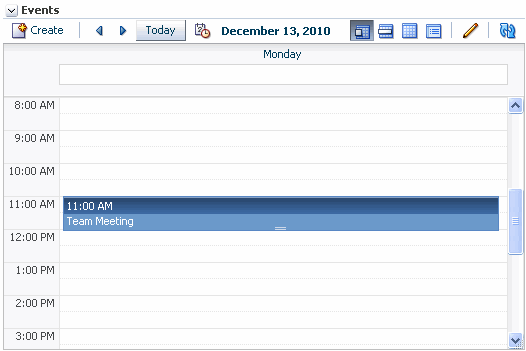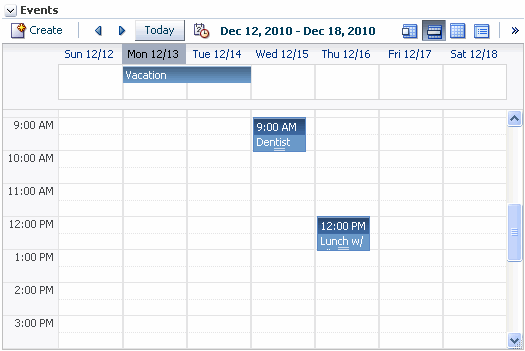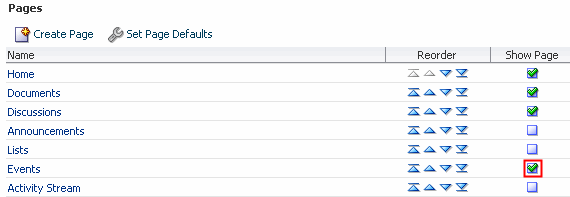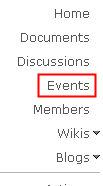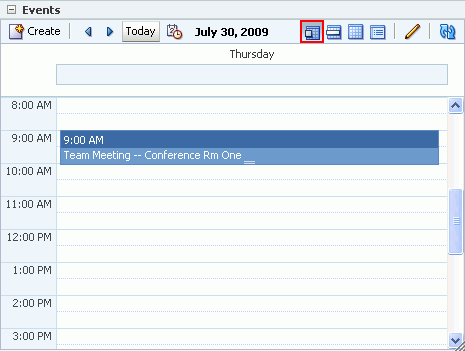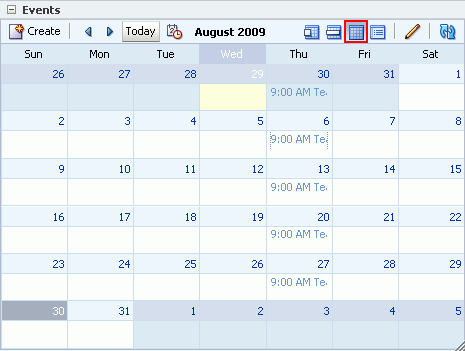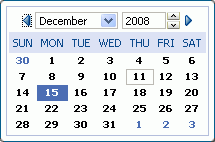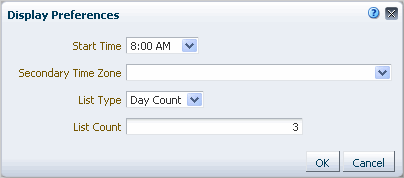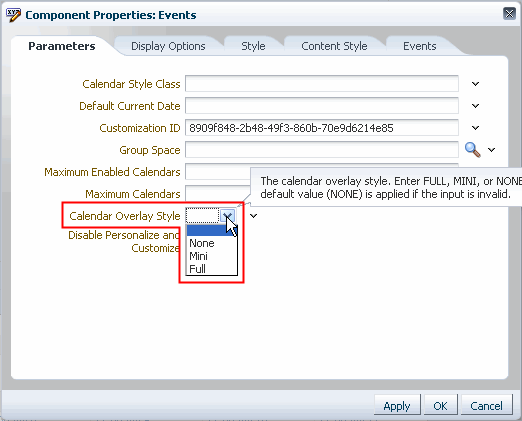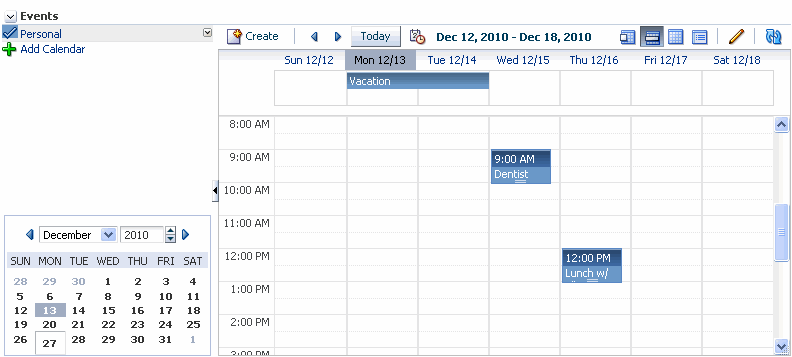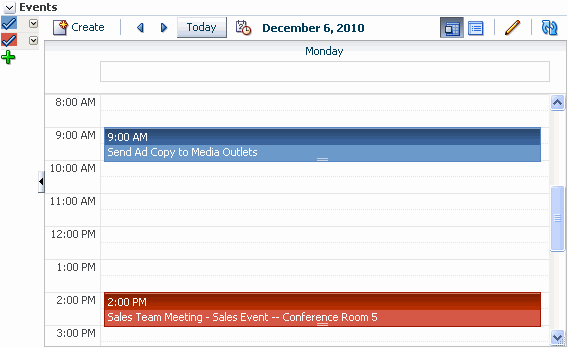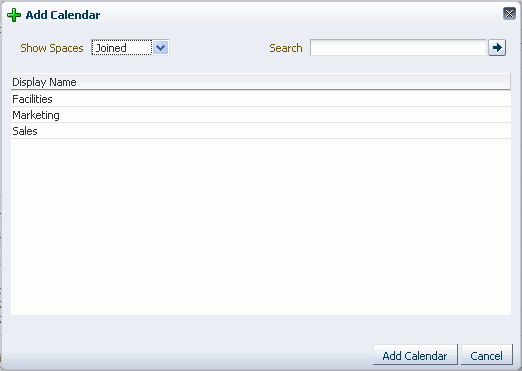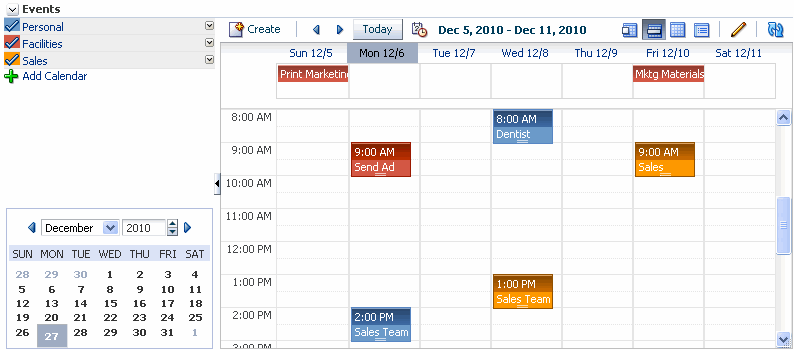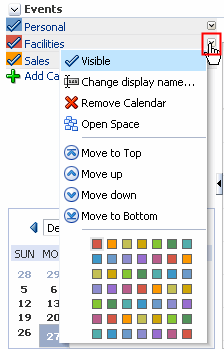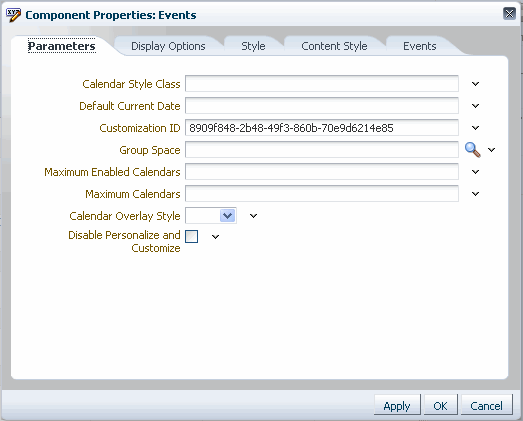61 Working with the Events Service
The Events service provides calendars that you can use to schedule meetings, appointments, and any other type of occasion. A dedicated Events page is available to every Space where the Space's moderator has enabled the Events service.
The Events service also enables you to view your own personal Microsoft Exchange calendar within your Home Space. In addition, you can overlay Space calendars on top of that calendar, so that you can view your entire schedule in a single calendar.
WebCenter Portal Applications:
The Events service is also available in WebCenter portal applications to provide access to users' personal calendars.This chapter explores the features offered through the Events service. It contains the following sections:
This chapter is intended for WebCenter Spaces users who want to use Events service task flows to schedule and track events. Users with a Space role that includes the permissions Create, Edit, and Delete Events (for event-related tasks), Edit Pages (to add the Events task flow to a page), and Edit Task Flows (to enable calendar overlays). For more information, see Section 52.2.1.2, "Understanding Permissions and Permission Models in a Space."
Note:
Tasks discussed in this chapter are not available if the Events service is not enabled in the current Space.61.1 What You Should Know About the Events Service
Events include appointments, meetings, presentations, and so on. Within WebCenter Spaces, there are two kinds of events:
-
Personal Events are those that concern only you. They could include things like dentist appointments or lunch with a friend.
Personal Events come from your Microsoft Exchange calendar and display only to you and only in Events task flows that are located on pages in your Home Space.
WebCenter Portal Applications:
Personal Events are also available in WebCenter portal applications. -
Space Events are those that are related to a specific Space. They could include weekly meetings or presentations.
Space Events display to all members of the Space on the Space's dedicated Events page or in any Events task flow that is located on a page in the Space. Members with the required level of permission can schedule or update events.
WebCenter Portal Applications:
Space Events are not available in WebCenter portal applications.Note:
If your application uses WebCenter's default user roles, then the required permissions to create an event are included in both the participant and moderator roles. Participants and Moderators can manage all events.
61.1.1 Calendar Overlaying
In addition to displaying your personal Microsoft Exchange calendar, in the Events task flow in your Home Space you can overlay your personal calendar with events from significant Spaces. In this way, you can have all your important events available in one location, rather than having to go to multiple Spaces to manage your daily schedule. In a Space, if you can create a page and add an Events task flow to it, you can also extend that task flow to display events from other Spaces. This is useful if some Spaces are very closely connected with similar membership lists.
Note:
The Events page displays only Space Events from the current Space.61.1.2 Where to View Events
Your application may provide a variety of locations from which to view events.
-
You can add the Events task flow to any page in a Space (Figure 61-1).
-
Every Space includes an Events page (a page with the Events calendar task flow) that can be displayed or hidden. If you cannot see the Events page, it could be hidden. For information about how to show it, see Section 61.2.3.1, "Displaying the Events Page for a Space."
-
You can also add the Events task flow to a page in your Home Space. In a Home Space, the task flow does not initially display the calendar of events. Instead it displays a link prompting you to Login to Personal Calendar (Figure 61-2). For information about logging in to your Microsoft Exchange calendar, see Section 61.2.2, "Accessing Your Personal Microsoft Exchange Calendar."
If you do not have a Microsoft Exchange calendar, or do not want to display Personal Events, but still want to view Space Events in your Home Space, enable calendar overlaying and then click Continue (Figure 61-3). For information about calendar overlaying, see Section 61.2.8, "Displaying Multiple Calendars in a Single Task Flow."
Figure 61-3 Events Task Flow in Home Space with Calendar Overlay Enabled

Description of "Figure 61-3 Events Task Flow in Home Space with Calendar Overlay Enabled"
61.1.3 Integration with Other Services
Through its tight integration with the Links service, the Events service provides the opportunity to associate events with other WebCenter Spaces items. Linking enables you to associate documents, notes, announcements, discussions, and URLs with an event. You can create links from an event by editing the event and clicking the Links icon. For more information, see Chapter 63, "Working with the Links Service."
The Events service also enables you to send email about an event to members of the Space. You can send mail from an event by editing the event and clicking the Send Mail icon. For more information, see Chapter 6, "Configuring Send Mail Notifications for WebCenter Spaces."
61.2 Working with Events Service Task Flows
Meetings are a fact of life. The art is in keeping on top of all those meetings, making sure you can attend all those that matter and keep abreast of what is going on.
Note:
The steps in the following sections apply to both Personal Events and Space Events. Where there are any differences, these are noted.This section includes the following subsections:
-
Section 61.2.1, "Adding an Events Service Task Flow to a Page"
-
Section 61.2.2, "Accessing Your Personal Microsoft Exchange Calendar"
-
Section 61.2.8, "Displaying Multiple Calendars in a Single Task Flow"
61.2.1 Adding an Events Service Task Flow to a Page
To add an Events service task flow to a page:
-
Open the page in edit mode.
See Also:
For more information, see Section 17.3.1, "Entering and Exiting Page Edit Mode." -
Click Add Content in the target region to open the Resource Catalog.
-
Navigate to the section of the Resource Catalog that contains the Events service task flows or search for the task flow.
Tip:
The presence or location of this component depends on how the Resource Catalog is configured. For example, in the default Resource Catalog, next to Social and Communication, click Open to expose a list that includes the Events service task flows. -
Click Add next to the task flow that you want to add to your page.
61.2.2 Accessing Your Personal Microsoft Exchange Calendar
You may maintain a calendar of events outside of WebCenter Spaces that does not relate to specific Spaces. If you use Microsoft Exchange 2003 or 2007 for this calendar, you can include the information in your WebCenter Spaces Home Space. This keeps all your calendar information in a single place, making it much easier for you to organize your day.
You can view your Exchange calendar in your Home Space. You can also edit or delete those events or create new Personal Events that are pushed to your Exchange calendar.
Note:
You can use calendar overlaying to display Space Events alongside Personal Events in your Home Space, but you cannot push Space Events into your Exchange calendar.For more information about calendar overlaying, see Section 61.2.8, "Displaying Multiple Calendars in a Single Task Flow."
Before you can access your Microsoft Exchange calendar in WebCenter Spaces, your administrator must have created a connection to the Microsoft Exchange Server. For more information, see the chapter “Managing the Events Service” in the Oracle Fusion Middleware Administrator's Guide for Oracle WebCenter.
To access your Microsoft Exchange calendar:
-
In your Home Space, locate the page where you want to add your Microsoft Exchange calendar.
-
Edit the page and add the Events task flow to the appropriate region on the page.
For more detailed information, see Section 61.2.1, "Adding an Events Service Task Flow to a Page."
-
Click Save and then Close.
-
In the Events task flow, click Login to Personal Calendar.
Note:
If you see the link Try Again instead of Login to Personal Calendar, there is a problem with the connection to the Microsoft Exchange Server. Contact your administrator. -
Enter your Microsoft Exchange login credentials and click OK.
61.2.3 Viewing Events
You can view events as a grid or a list; choose to display events a day, a week, or a month at a time; select the range of hours displayed per day; and include a second time zone in the display.
This section includes the following subsections:
61.2.3.1 Displaying the Events Page for a Space
In every Space, Space Events display on the Events page. However, the Events page may not display by default. If so, it is easy to display the Events page using the Manage Pages dialog.
Note:
Home Spaces do not have an Events page.To display the Events page:
-
Go to the Space where you want to display the Events page.
-
From the Page Actions menu, choose Manage, then Pages (Figure 61-5).
-
On the Pages page, select the Show Page checkbox for the Events page. (Figure 61-6).
-
In the Space, there is now a link to the Events page (Figure 61-7).
-
If you later decide that you no longer want to display the Events page, from the Page Actions menu, choose Manage, then Pages, and uncheck the Show Page checkbox fro the Events page.
61.2.3.2 Displaying Events by Day, Week, or Month or as a List
You can use icons on the Events task flow or Events page toolbar to display events in grid form or in list form (Figure 61-8).
When you display events as a grid, you can display events by day, week, or month. When you display events as a list, the number of upcoming events listed depends on the display options for the task flow (for more information, see Section 61.2.3.5, "Setting Display Preferences.")
To display events by day, week, or month or as a list:
-
Go to the Events task flow (or Events page) where you want to view events.
If the Events page is not available, see Section 61.2.3.1, "Displaying the Events Page for a Space."
-
On the toolbar:
-
Click the Day icon to display the calendar one day at a time (Figure 61-9).
-
Click the Week icon to display the calendar for the whole week (Figure 61-10).
-
Click the Month icon to display the calendar for the whole month (Figure 61-11).
-
Click the List icon to display a list of upcoming events (Figure 61-12).
The calendar refreshes and appears in the selected mode.
-
61.2.3.3 Viewing Events for a Specific Date
Usually, in grid mode, the Events page or Events task flow displays events for the current day, week, or month. To view events for a specific point in time, you can use the previous or next buttons or select a date so that the calendar displays events for a specific date.
To select a date:
-
Go to the Events task flow (or Events page) where you want to view events.
If the Events page is not available, see Section 61.2.3.1, "Displaying the Events Page for a Space."
-
On the toolbar, click the Previous or Next icon until the appropriate date is displayed.
In Day view, this displays the previous or next day. In Week view, this displays the previous or next week. In Month view, this displays the previous or next month. In List view, this displays the previous or next number of days as specified in the Display Preferences.
Note:
For information on the Display Preferences for List view, see Section 61.2.3.5.3, "Configuring List View." -
If you know the specific date for which you want to view events, on the toolbar, click the Select Date icon (Figure 61-13).
The date picker opens (Figure 61-14). Today's date is boxed, and the currently selected date (which may also be today's date) is highlighted. For example, in Figure 61-14, today's date is the 11th and the selected date is the 15th.
Note:
If the calendar overlay feature is enabled in Full mode for the task flow, the Date Picker is always visible to the left of the calendar. -
Use the date picker to select the month, year, and day.
For example, select a month from the dropdown list; select a year using the controls to the right of the current year, or enter the value yourself; click a date to select a day. Once you select a day, the date picker closes and the calendar shows events for that date.
-
To quickly return to today's date, click the Today button.
61.2.3.4 Refreshing Your View of Events
The Events task flow and Events page include a Refresh icon that you can use to refresh your calendar (Figure 61-15).
This is useful for updating your view of the calendar with any recent changes made by other users. Click the Refresh icon and the calendar redraws, reflecting recent changes.
61.2.3.5 Setting Display Preferences
Events service display preferences:
-
Determine the earliest time displayed on the calendar when events are viewed by day or week.
-
Identify a secondary time zone.
-
Specify how to display events in List view: by day, week, month, or for a specified number of days.
You set these preferences in the Display Preferences dialog (Figure 61-16).
This section includes the following subsections:
61.2.3.5.1 Setting the Calendar Start Time
In Day and Week view, the calendar grid is divided into hours. If vertical space for your calendar is limited, you can specify the earliest hour to display on the calendar grid to save space. If the space available is big enough to display hours from before the specified start time up until 11PM, it does so.
To set the calendar start time:
-
Go to the Events task flow (or Events page) where you want to set the calendar start time.
If the Events tab is not available, see Section 61.2.3.1, "Displaying the Events Page for a Space."
-
Click the Set time display preferences icon on the toolbar (Figure 61-17).
-
In the Display Preferences dialog (Figure 61-16), from the Start Time dropdown list, select the earliest hour to display on the grid.
Choose from 12AM to 11PM.
-
Click OK to save your changes.
61.2.3.5.2 Setting a Secondary Time Zone
In these days of distributed workforces, it is not unusual to be working in teams with members in different locations. When scheduling meetings, it is useful to know the hours most optimal to all invitees. To make this easier, you can specify a secondary time zone to see what time a meeting is in that time zone as well as your own.
When you hover your mouse over an event, the event details popup shows the time of the meeting in your time zone and in the secondary time zone (Figure 61-18).
To set a secondary time zone:
-
Go to the Events task flow (or Events page) where you want to set time display preferences.
If the Events tab is not available, see Section 61.2.3.1, "Displaying the Events Page for a Space."
-
Click the Set time display preferences icon on the toolbar (Figure 61-19).
-
In the Display Preferences dialog (Figure 61-16), from the Secondary Time Zone dropdown list select a secondary time zone to display along with the primary time zone.
-
Click OK to save your changes.
61.2.3.5.3 Configuring List View
You you can specify how you want to display events, when the calendar is displayed in List view. You can display events by day, week, month, or for a specified number of days.
To configure List view:
-
Go to the Events task flow (or Events page) where you want to set time display preferences.
If the Events tab is not available, see Section 61.2.3.1, "Displaying the Events Page for a Space."
-
Click the Set time display preferences icon on the toolbar (Figure 61-20).
-
In the Display Preferences dialog, from the List Type list, choose how you want to display events in List view:
-
Day Count—List all upcoming events for a specified number of days.
-
Day—List all upcoming events for the currently selected day.
-
Week—List all upcoming events for the currently selected week.
-
Month—List all upcoming events for the currently selected month.
-
-
If you selected Day Count in the previous step, in the List Count field, specify the number of days for which you want to display events. The default is 14.
-
Click OK to save your changes.
61.2.4 Scheduling Events
You can schedule Space Events and Personal Events. When you schedule a Personal Event, the details are pushed to your Microsoft Exchange calendar.
To schedule an event:
-
Go to the Events task flow (or Events page) where you want to schedule an event.
If the Events tab is not available, see Section 61.2.3.1, "Displaying the Events Page for a Space."
-
Click the Create a new event icon on the toolbar (Figure 61-21).
The Create Event dialog opens (Figure 61-22). The fields in the Create Event dialog are slightly different depending on whether you are creating a Personal Event or a Space Event. For Space Events, the dialog includes a Category dropdown list; for Personal Events, the dialog includes a Private checkbox. These options are described in further detail later in this procedure.
Note:
You can also easily invoke the Create Event dialog in grid view by double-clicking an empty space or right-clicking an empty space and choosing Create. The advantage of this is that the date and time of the event are automatically specified in the dialog.Figure 61-22 The Create Event Dialog Invoked from a Space
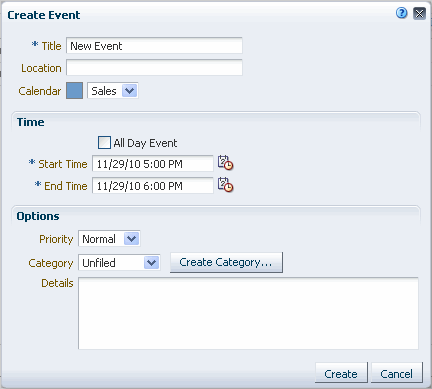
Description of "Figure 61-22 The Create Event Dialog Invoked from a Space"
-
In the Title field, enter a brief descriptive title for the event.
For example,
Project Update. -
In the Location field, enter the location of the event.
For example,
Conference Room 5. -
From the Calendar dropdown list, select the calendar against which you want to create the event.
If you do not have the calendar overlay feature enabled, there is only one option in this list: the calendar for the current Space or Home Space (depending on where you are creating the event). For more information about calendar overlays, see Section 61.2.8, "Displaying Multiple Calendars in a Single Task Flow."
-
In the Time section, select All Day Event to block out the entire day for the event.
All-day events can span multiple days.
-
In the Start Time field enter a date and time to start the event. You can click the Select Date and Time icon and select a start time from the Date Picker, if you prefer.
-
In the End Time field enter a date and time to finish the event. You can click the Select Date and Time icon and select an end time from the Date Picker, if you prefer.
Note:
All selections under the Options section are optional. -
In the Options section, assign a priority for the event: Highest, High, Normal, Low, or Lowest.
The priority of an event determines where it appears when events clash. An event with Highest priority is displayed first.
-
Select a category to classify this event from the Category dropdown list.
Optionally, click the Create Category button to create a category and automatically select it for this event.
Categories are useful for creating distinct groups of events, organized according to their general purpose.
Note:
The Category dropdown list is available only for Space Events. -
In the Details text box, enter any additional details you want to include, up to a maximum of 4000 characters.
For example, you might want to describe the purpose of the meeting, provide a brief agenda, or indicate if attendees need to prepare anything for the meeting.
Note:
The details that you enter here are available only when editing the event, they do not display in the event popup when users hover over the event. You should not assume that all users will read these details. Important details about the meeting should be communicated in a different way, for example, through the meeting notification email or by using an announcement. -
Select the Private checkbox if you do not want other users to be able to view the event.
If the Events task flow is included on page in your Home Space that you have made available to other users, those users are not able to see the event.
-
Click Create to add the event to the calendar (Figure 61-23).
61.2.5 Viewing Event Details
The Events page or Events task flow displays basic information about events. To view more information, such as the location or start and end times, simply hover your mouse over an event.
To view event details:
-
Go to the Events task flow (or Events page) where you want to view event details.
If the Events page is not available, see Section 61.2.3.1, "Displaying the Events Page for a Space."
-
Hover the mouse over a link to an event to display the event details (Figure 61-24).
To view the priority, category, or details of the event you must edit the event. For more information, see Section 61.2.6, "Revising Scheduled Events."
61.2.6 Revising Scheduled Events
You may want to change some aspect of an event; for example, it may become necessary to change the time to accommodate a particular attendee, or the location may become unavailable.
To revise a scheduled event:
-
Go to the Events task flow (or Events page) where you want to revise a scheduled event.
If the Events page is not available, see Section 61.2.3.1, "Displaying the Events Page for a Space."
-
Right-click the event and choose Edit (Figure 61-25).
The Edit Event dialog opens (Figure 61-26).
You can also access the Edit Event dialog by clicking an event, or by moving the mouse pointer (or using the Tab key) to highlight an event and pressing Enter.
Figure 61-26 The Edit Event Dialog Invoked from a Home Space
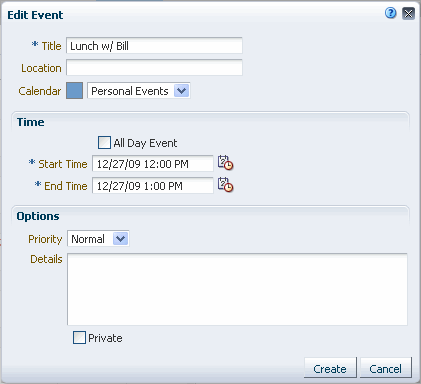
Description of "Figure 61-26 The Edit Event Dialog Invoked from a Home Space"
-
Revise the event details.
For information about the different options available in the dialog, see Section 61.2.4, "Scheduling Events."
-
Click Update to save your changes.
61.2.7 Cancelling Scheduled Events
To cancel an event, you delete it from the Events page or task flow.
To cancel a scheduled event:
-
Go to the Events task flow (or Events page) where you want to cancel a scheduled event.
If the Events tab is not available, see Section 61.2.3.1, "Displaying the Events Page for a Space."
-
Right-click the event and choose Delete (Figure 61-27).
You can also delete an event by hovering your mouse over the event and pressing the Delete key or, in the Edit Event dialog, clicking Delete.
-
Click Delete in the Delete Confirmation dialog.
The event is removed from the calendar.
61.2.8 Displaying Multiple Calendars in a Single Task Flow
Within WebCenter Spaces, you may be a member of several Spaces. Each of those Spaces probably has its own calendar of events. In addition to that, you may also have your own calendar where you track those events that concern only yourself. At the start of each day, you probably do not want to view each of these calendars individually to determine your schedule for the day.
To solve this issue, the Events service enables you to view multiple calendars in a single Events task flow. This is called calendar overlaying. You can do this in your Home Space so that you can also include your personal appointments. You can also overlay calendars in an Events task flow on a Space page.
Note:
The events from each calendar are displayed in a different color to help identify the source of the event.For example, you might have a sales event that involves your Marketing, Sales, and Facilities departments. You want to create a calendar that includes events and tasks for all the departments so that each group has a clear picture of the overall plan. To create the sales event calendar:
-
Create a Space for the sales event.
-
Create Spaces or Subspaces for each department (Marketing, Sales, and Facilities), adding the Events Task Flow to each Space/Subspace, then adding events to each calendar.
-
Add the Events Task Flow to the sales event Space, overlaying the calendars from the Marketing, Sales, and Facilities Spaces/Subspaces.
This section includes the following subsections:
61.2.8.1 Enabling Calendar Overlaying
To display additional calendars in the Events task flow, you must first enable the calendar overlaying feature for the task flow.
To enable calendar overlaying:
-
Go to your Home Space or the appropriate Space and locate the page that contains the Events task flow.
If you have not yet added the Events task flow to a page, see Section 61.2.1, "Adding an Events Service Task Flow to a Page."
-
Open the page in edit mode (Oracle Composer) by pressing Ctrl+Shift+E.
-
Click the Edit icon (wrench) for the Events task flow.
Note:
If you are working in a Space, you may not have the appropriate permissions to edit the task flow. To enable calendar overlaying, contact the Space moderator. -
In the Component Properties: Events dialog, click the Parameters tab.
-
From the Calendar Overlay Style dropdown list, choose:
-
Full to use a detailed calendar overlay. Use this option if space is not an issue on the page and to provide a richer user interface.
-
Mini to use a more compact view of the calendar overlay. This takes up less space on the page, but it might not be immediately obvious how to work with the overlays. Use this option if space is very limited on the page, or when your users have become familiar with calendar overlays and how to use them.
-
None if you do not want to use calendar overlays.
-
-
Click OK to save your changes and exit the Component Properties dialog.
-
Click Save at the top right of Oracle Composer to save your changes.
-
Click Close at the top right to exit Oracle Composer.
The Events task flow now includes an area to the left of the calendar where you can choose other calendars to display in the task flow.
If you selected the Full option for the Calendar Overlay Style, the calendar overlay area includes text as well as icons and also includes a date picker to help you easily move around your calendar (Figure 61-29).
If you selected the Mini option for the Calendar Overlay Style, the calendar overlay area is much smaller, displaying icons only and no date picker (Figure 61-30).
Note:
If you have not yet set up and logged in to your personal calendar, click the Continue link to display the calendar in the task flow. For information about how to set up your personal calendar, see Section 61.2.2, "Accessing Your Personal Microsoft Exchange Calendar."
61.2.8.2 Displaying Additional Calendars
When the calendar overlaying feature is enabled, users can display as many calendars as they want in the Events task flow. Each calendar's events are displayed in a different color to make it easier to distinguish which calendar it belongs to.
To display additional calendars:
-
Go to your Home Space or the appropriate Space and locate the page that contains the Events task flow.
-
In the calendar overlay area of the Events task flow, click the Add Calendar icon.
-
In the Add Calendar dialog (Figure 61-32), select the Space that provides the calendar that you want to display in the task flow.
You can select multiple Spaces.
-
Click Add Calendar.
The calendar overlay area now includes the selected Space and the calendar on the right includes events from that Space. The events from each Space are displayed in a different color.
61.2.8.3 Editing Calendar Display Options
After adding a Space's events to your calendar you can change various display options, including the order the calendar appears in the list and the color used to identify events from the calendar.
To edit calendar display options:
-
Go to your Home Space or the appropriate Space and locate the page that contains the Events task flow.
-
Click the arrow icon to the right of the Space for which you want to edit display options. This displays the calendar overlay popup menu (Figure 61-34).
-
From the popup menu, choose:
-
Visible to toggle the display of this Space's events in the calendar.
You can also toggle the display of a Space's events by clicking the Space name (Full view only) or the colored square next to the Space name.
-
Change display name to make the name in the list of Spaces in Full view more meaningful to you than just the Space name.
-
Remove Calendar to remove this Space's calendar from the task flow.
-
Open Space to open the Space associated with this calendar.
-
Move to Top/Move up/Move down/Move to Bottom to rearrange this Space in the list.
The order in which the Spaces are listed determines the order in which events are listed when events from multiple Spaces occur in the same time slot. Events from the Space at the top of the list are displayed first.
-
A color to change the color used for the events from this Space.
-
61.3 Setting Events Service Task Flow Properties
The Events service task flows have associated properties, which users with sufficient privileges can access through the Component Properties dialog in Oracle Composer (Figure 61-35).
For information about accessing the Component Properties dialog, see Section 17.5.2.3, "Setting Component Properties."
The following sections provide information about properties of the Events service task flows and describe the properties on the Parameters tab:
61.3.1 What You Should Know About the Events Service Task Flow Properties
The properties on the Parameters tab of the Component Properties dialog control the default task flow content. For descriptions of the parameters on this tab, see Section 61.3.2, "Events Service Task Flow Parameters." For some task flows, parameters on this tab facilitate the wiring of the task flow to page parameters and page definition variables. For information about wiring pages and components, see Chapter 19, "Wiring Pages, Task Flows, Portlets, and UI Components."
Changes to the properties on the Display Options, Style, and Content Style tabs affect the appearance and behavior of the task flow for all users. These properties are common to all task flows. For more information, see Section 17.5.2, "Setting Properties on Page Components."
The contents of the Events tab depend on the events supported by the task flow. For more information, see Section 17.5.2.8, "Working with Component Contextual Events."
The Child Components tab displays all of the components contained within the current component. It provides controls for rearranging, showing, and hiding child components. Not all components contain children. So this tab may be omitted. For more information, see Section 17.5.2.6, "Working with Child Components."
All properties on the Parameters and Display Options tabs provide access to an Expression Language (EL) editor, which you can use to select or specify a variable value instead of a constant value. Click the Edit icon next to a property field to open the editor. For more information about using the editor and for descriptions of common EL expressions, see Appendix B, "Expression Language Expressions."
61.3.2 Events Service Task Flow Parameters
Table 61-1 describes the parameters that are unique to the Events service task flow.
Table 61-1 Events Service Task Flow Parameters
| Property | Description |
|---|---|
|
The name of the custom style class you want to apply to the calendar component. |
|
|
The default current date on the calendar. Valid values are:
|
|
|
A unique identifier for event view customization. Customization ID assists with maintaining the association of this task flow instance with its customization and personalization settings. This value is set automatically. Do not edit this value. |
|
|
The name of the Space that is the source of listed events. Valid values are:
The Space display name is available on the General page in the Space administration settings. |
|
|
The maximum number of calendars that a user can display simultaneously. This value must not be greater than the value specified for Maximum Calendars. Default value: The same value as that specified for Maximum Calendars |
|
|
The maximum number of calendars that a user can add to the task flow. When the maximum is reached, the Add Calendar icon no longer appears in the task flow. Default value: 20 |
|
|
Whether calendar overlay is enabled. Valid values are:
|
|
|
Whether users can personalize or customize the task flow. If selected, users can personalize and customize the task flow. |
61.3.3 Events - Mini View Task Flow Parameters
Table 61-1 describes the parameters that are unique to the Events - Mini View task flow.
Table 61-2 Events - Mini View Task Flow Parameters
| Property | Description |
|---|---|
|
Custom calendar toolbox layout. The value will be passed to the ADF calendar component as an attribute toolboxLayout. |
|
|
A unique identifier for event view customization. Customization ID assists with maintaining the association of this task flow instance with its customization and personalization settings. This value is set automatically. Do not edit this value. |
|
|
Number of days for upcoming events. Default value: 30 |
|
|
The maximum length of event text displayed in mini view. Default value: 18. No truncation will be made if value is 0. |
|
|
Number of events per page. Default value: 5 |
|
|
A switch to use ADF Calendar UI Component or simple list with page flow in events mini view. Default value: false. |
